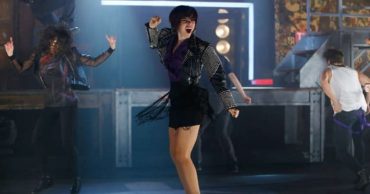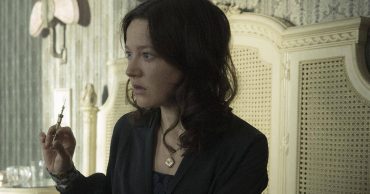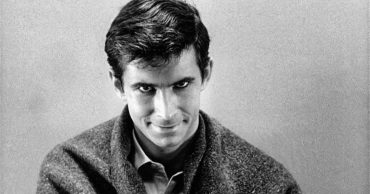
What if I told you I saw a sweet indie film about the financial crisis that was more about how it affected everyday people’s lives than about the few people who caused it – and that it wasn’t a downer? Surprising, right? Well, there is such a film. It’s called Almost Paris. Sadly, it’s possible you may never see it.
Now, a lot of good films get made that are never seen, but the situation for this one is kind of funny, because everything about it suggests that distributors would be fighting over the opportunity to show it. I’ll explain why that is a bit later, but the fact that the film has gotten barely a mention anywhere is perplexing – but not really. This film’s director is a woman – and it’s her first feature.
Already, I imagine some people are groaning. Like, really, that’s the excuse you’re coming up with? Yes, it is – because what lies beneath the gender gap in Hollywood is not simply a matter of one’s physical gender. When I look at the factors behind this movie, and the Hollywood culture of celebrity, the prejudice against female directors and the stories they choose to tell is the only thing that fits. When I give you the specifics you’ll see what I mean. For now, let’s look at the situation within the current climate of Hollywood – without the details of who’s behind this film.
Women and Hollywood – The Issues
There’s always been a lot of talk about the lack of female directors – overall gender inequality – in the movie business. The organizations Women Make Movies and Women in Film were respectively founded in 1972 and 1973, so this is hardly a new problem. However, in October of 2015 the federal Equal Employment Opportunity Commission began an investigation about the lack of female directors in Hollywood. Yes, it’s become that serious.
Cannes 2016
The latest round of criticism in this area has occurred around the just finished Cannes Film Festival. In the lead up to its opening night the festival once again found itself under fire around issues of inclusiveness. Now, it’s not that those films lucky enough to have made the cut are bad – the reports out of Cannes have had a few positive mentions. However, the lack of female directors in competition (there are 3) and of first time directors to the competition (there are 4) does give those who keep an eye on these things pause.
In interviews the festival director Thierry Fremaux is on record as not being too concerned. On the issue of new directors, he is only slightly defensive about the number of returning directors. The reason? Fremaux is quite clear that his job is to uphold…a certain standard of filmmaking.
Cannes is Cannes. People don’t expect the Louvre Museum to take down its Old Masters in a bid to reinvent its collection. That would be like saying, “Hey let’s get rid of the Mona Lisa.” It wouldn’t be the Louvre. At Cannes, we specialise in the big auteurs. Once upon a time it was Fellini, Antonioni and Bergman, then Tarkovsky and Co in the 1970s. Today, it’s those auteurs we invite back time and time again.
This is not a good analogy. No one is suggesting getting rid of Fellini. I wonder if he realizes that he’s suggesting that Cannes is a place that doesn’t allow for modern sensibilities in filmmaking and that the art should be frozen in time? Even the Louvre has galleries that showcase modern works. Currently there’s an exhibition called Founding Myths that feature an ancient statue of Hercules standing next to Darth Vader….
Fremaux words, intentionally or not, say Cannes isn’t a place for a filmmaker expanding on the language of film or even embarking on new ways of speaking. While anyone who loves film certainly reveres the names he mentions, they are not the end of the line. The world stage – and thus the topics of conversation for a film’s subject – has grown much larger since then. Likewise our technology has created possibilities those great auteurs could never dream of.
Of course, none of the greats listed are women either. Fremaux is even less concerned about how Cannes is doing in that area. In fact, he suggest the festival is ahead of the curve.
Nine out of 49 of the filmmakers are women. That’s 20% of the selection. What percentage of film-makers in the world are women? According to a recent report, it’s 7%.
First of all, I would love to see how any report could give us the number of, “film-makers in the world” to take a percentage from. My guess is he’s referring to the 2014 study from The Center for the Study of Women in Film and Television, which said 7 percent as the women directors helming the top 250 domestic-grossing US market films. The 2015 numbers for that same demographic are actually 9 percent. That increase doesn’t mean things have really improved overall, since that 9 percent figure was the same in 1998. We have not come a long way, baby.
On the other hand, if you look at the number of women directors for independent films in 2015, you go up to 28 percent. This is a definite improvement, although, it doesn’t reflect the numbers of women graduating from film schools. Fremaux claims that, “…more needs to be done in the film schools, the universities and the production houses, to favour women…” in order for there to be more female filmmakers at Cannes.
That statement doesn’t make a lot of sense. Currently half the film school graduates from NYU & USC are women – which is up from the 34 percent that there were in 2010. Both figures are markedly higher than the 9 percent in the study – or Fremaux‘s 20 percent. Incidentally, Indie Wire points out that Fremaux’s 20 percent figure for films at the festival includes its non-competition films. Of the 21 films in actual competition, only three are female directed, which brings his figure down to 14 percent.
Clearly, the issue is not with the film schools, but with everything that comes after it. Michael Phillips of the Chicago Tribute states the real issues in his article regarding the 2015 Oscar nominees:
Decades from now, maybe it’ll be easier to discuss the Oscars without breaking everything down by ethnicity and gender. We’ll only need to change the entire makeup of the academy membership, not to mention the power structure of the film industry, for that to happen.
The Academy is now working on that first part, but they have no authority on the second. Although Cannes isn’t a studio, it is definitely a part of that power structure. It’s one of a handful of festivals where a winwin can position a film for the Oscar race.
What does any of this have to do with Almost Paris? Quite a bit, but in order to really see the point, there’s a lot of background to be laid.
One of those female directed non-competition films at Cannes was Money Monster. It’s a small, big budget Hollywood film with proven Hollywood royalty: The film stars George Clooney & Julia Roberts and it’s directed by Jodie Foster. In an interview at the 2016 Tribeca Film Festival she refers to it as “a genre film” and “a popcorn movie.”
The backdrop for Money Monster is the 2008 financial crisis and it involves guns, bombs, a television studio and a hostage situation. In terms of Fremaux’s ideals about preserving the classics, while the film may not have the depth of a Fellini in terms of visual style Deadline and Variety both make reference to Sidney Lumet. In other words, of course it’s showing at Cannes – it fits into the line of Fremaux’s historic best of Hollywood aesthetic. In this respect it’s great that Cannes screened Money Monster because at least it shows that if you meet all the criteria of Fremaux’s traditional cinema you’re in – regardless of gender.
Truthfully, if Cannes were the only place with the kind of ideals it holds there wouldn’t be a problem. It would simply be one festival with a specialized criteria – and that would be all. Unfortunately, it’s the biggest film festival in the world and many see it as a pipeline to the Oscars. As such, it serves as a perfect example of the Hollywood problems around diversity in general, and in particular, around female directors.
Diversity and Female Directors
Foster actually spoke about this problem at the Tribeca Film Festival on one of the special director’s panel. She starts off saying that she’s “sick of the woman question” – but that’s because she’s wants there to be a day where it’s no longer an issue. In terms of the specific question du jour of, “why aren’t there more women directing big budget movies” she describes it as simplistic and cites factors from “our psychology” to “the global economy.”
Foster: It would be nice to have a more complex conversation and to be able to look at it more than just a quota or numbers.
However, Foster does hit on a couple of key points. The first is strictly about money.
The more the financial risk (…) the less risky the studios can be, and I think that people still see, for whatever reason, I don’t think it’s a plot, but I think they still see women as a risk – and I’m not really sure why.
This point certainly goes to why the number of female directors doing independent film is so much higher than studio pictures, they use less money. As she said though, things are more complicated than numbers and quotas.
Her second point has to do with leadership style. Essentially, she suggests that because men and women have different leadership styles, studios actually don’t know how to deal with a female director. It’s an excellent point – and a great place to get to the heart of the problem. Hollywood doesn’t deal well with differences in story or style that veer from the traditional filmmaking that the art began with and that are so loved and admired – the so-called, “Golden Age” of Hollywood.
The last “great auteurs” are said to have come from the 1970’s – Hollywood’s second golden age. Unfortunately, the times of both Hollywood golden ages are times filled with racism and sexism. With those times filtered into the aesthetics of what makes a good film it’s not surprising that the industry has a never-ending game of whack-a-mole regarding discussions of all the ways not being a straight white male is a liability – regardless if the job is on or off screen.
At the 2016 Oscars Host Chris Rock made a lot of jokes about the “Oscars so white” issue that some found hilarious and others felt were completely offensive. Regardless of what you thought of them though, this one particular joke illustrates how a whack-a-mole approach to these issues of diversity is useless.
Rock: If you want black nominees every year, you need to have black categories. That’s what you need. … You already do it with men and women. Think about it. There’s no real reason for there to be a men and women category in acting. … It’s not track and field. You don’t have to separate them. Robert De Niro never said, ‘I better slow this acting down so Meryl Streep can catch up.’ No. Not at all man. If you want black people every year at the Oscars just have black categories, like ‘best black friend.’ And the winner, for the 18th year in a row, is Wanda Sykes. This is Wanda’s 18th black Oscar.
Rock’s joke both hits and misses it’s mark – but perhaps that was the intention. On the one hand it suggests that blacks need a separate category the way that men and women do and on the other it says women shouldn’t have them. Well, which is it?
The answer is neither – because the categories should stay as they are. The truth is that if actors and actresses didn’t have separate categories there is a good chance that Meryl Streep might have never won an Oscar. If that sounds extreme, take a look at the track record of women in all the other categories.
Here are some chart highlights: Only 10 percent of all screenwriting nominations have been for women and there have been eight women who have won Best Original Screenplay. Of the eight, four are co-written with men. (The first solo female writer to win was Callie Khouri for Thelma & Louise in 1991.) For directing it’s 1 percent of nominations which breaks down to 4 women in 86 years: Lina Wertmüller (Seven Beauties), Jane Campion (The Piano), Sofia Coppola (Lost in Translation) & Kathryn Bigelow (The Hurt Locker). There’s only one woman who has ever won, and that’s Bigelow. When you look at these numbers it stands to reason that without there being a category for actresses the category for acting would be subject to the same fate as that of screenwriting and directing. The work would be judged as having less value because those judging would relate to it less.
This is not exactly a conspiracy against women. Members of the Academy of Motion Picture Arts & Sciences (the Academy) pick its Oscar nominees based on the stories they find most relevant, most appealing, and that they connect to. As time has shown, those choices tend to fall into the sphere of white, male-driven stories, or white male fantasies. Likewise, when it comes to seeing women in positions of authority, Hollywood and the Academy suffer from the same thing that Warren Buffett writes about in terms of corporate America. He states that there is a lack of gender balance in the boardrooms, one that exists because of how things have been historically, and the psychology of men and women. He sees this gender imbalance as detrimental to our overall economics. The issues he mentions that cause the problem are similar to the issues that Foster brought up in her Tribeca interview.
The above is why African-Americans, Hispanics, Asians…or basically anyone who isn’t a white male are in a similar situation when it comes to working in the entertainment industry. To be clear, while I am focusing on gender in this article, when you go to look at things like non-white director nominations the numbers are just as dismal. That’s the reason that Rock could even make the joke he does and have something about it ring true. There is an underlying connection between the issues in terms of women and those who aren’t white being overlooked and less valued.
All of this brings us full circle to what Rock was joking about: why not just add separate acting categories based on race? The answer is that while the issues have some things in common, they are not the same. Male and female is a universal binary that’s been around since way before the dinosaurs. Yes, we all fall under the species Homo Sapiens, but even the definition of, “species” includes the ability to “mate and produce fertile offspring.” Our species is divided into two types – male and female – and that’s throughout the animal kingdom. In comparison, race is a recent construct and racism is strictly human: you don’t see a golden retriever refusing to play with a black lab because he doesn’t like the color of the lab’s fur. Only humans seem to go to the idea that one dog is somehow better and fundamentally different from another based on its physical traits.
After winning the SAG award for best actress in a TV series, Viola Davis spoke to the fact that the race issue is about a viewer’s willingness, “to be open to the experience of the story.” She also inadvertently makes the same point that shows how race and gender issues – while being related – are not the same thing.
I mean, when you watch Annalise [on How to Get Away With Murder], she’s not just a black woman, she is a woman going through her life, you know? (…) I’m just saying, plop your money down to see Race, to see Dope, to see Straight Outta Compton, to see Selma, do support directors like Ava DuVernay, Lee Daniels, Spike Lee, that their stories are just as valid and as important as anyone else.
The issue of racism is about the experiences of different races being included in the human story – it’s not just about white stories. However, within the human story – regardless of race – there are two parts: male and female. Gender issues are about those two parts being equally valued, even though there are differences between the two.
As mentioned earlier, Foster addressed one of those differences when she brought up leadership style. In the book, The Women of Berkshire Hathaway: Lessons from Warren Buffett’s Female CEOs this is discussed at length. It’s worth noting that the solution turned out not to be for women to act like men. Rather, women brought to the table new ways of doing things that were equally effective. It’s also been shown that corporations that have mixed gender boards outperform those with boards that are all male (www.ft.com). In short, having women in positions of equal power and authority as men contributes to a better overall productivity – and creativity. This is not by women “acting like men” – but by bringing a different approach to a shared goal.
This idea needs to be applied to directing. When Fremaux says he looks for films that remind him of the greats this very well may be shutting down the ability to expand the art and to see the greatness in story choices and approaches that don’t fit the model of the extreme conflicts and large-scale landscapes that are associated with the best of Hollywood.
Almost Paris
I did promise this would all come back to Almost Paris. Most of the movies on the subject of the U.S stock market collapse have focused on the glamour and dirty underbelly of the finance business and that one percent that caused so much mayhem in 2008. The Big Short and Wolf of Wall Street are probably the films that immediately come to mind. You know, the stories about the movers and shakers. Even Foster’s Money Monster is dealing in the extremes and the big personalities – Clooney’s over-the-top charlatan is described in the Variety review as, “a transparent stand-in for Jim Cramer of CNBC’s Mad Money
Almost Paris has a very different approach. Instead of celebrating the extremes of excess, depraved indifference, and deep despair, this dramedy takes a look at the cogs in the wheel that have been effected. You know, the ordinary people behind the statistics of loss that are tossed out when talking about how those big bankers screwed up. However, the core of Almost Paris is looking at the dynamics of families, friendship, and romantic love.
Here’s the actual plot summary:
In the wake of the mortgage-lending crisis, a former banker returns to his hometown. Faced with his family and childhood friends – and seeing the impact of his actions – our hero learns to show up and give back to those he loves in ways that are priceless.
Now for those particulars. The director is Domenica Cameron- Scorsese. Yes, that Scorsese – as in daughter of Martin Scorsese. It’s her first feature, and, in another first, his youngest daughter Francesca has her first speaking role. If that weren’t enough, Michael Sorvino, brother of Mira Sorvino and son of Paul Sorvino, is also in a featured role, as is Susan Varon– whom of course was in Goodfellas. Now, Varon has been directed by a second Scorsese. Honestly, the marketing for Almost Paris writes itself.
Picking this film up should be a no-brainer – and yet, you may never see it. You can however, get glimpses of it in this trailer:
[youtube https://www.youtube.com/watch?v=K2GwwM6feIA?rel=0]
Perhaps it’s because the subject matter and scale of Almost Paris is so intimate? This quote is from the New York Times 2015 piece: The Women of Hollywood Speak Out
The producer Mynette Louie hit the nail on the head when she labelled the “mini-me problem,” in which established directors keep an eye out for someone who reminds them of themselves, and they help that mini-me get ahead.
Martin Scorsese is known for showing us the darker sides of life and the vulnerabilities in characters that are huge, and in circumstances that tend to be outside of the norm. His daughter is clearly not a mini-me in terms of subject matter. Almost Paris has taken the largeness of the financial crisis. The film intimately focuses in on how individuals in the U.S. have been affected, and on how they are healing from it. There are no scenes of anyone being shot, raped or killed. Instead this Scorsese uses the lens to give the audience the rawness and humor of everyday moments in the lives of people who feel like they could be your next-door neighbor. The conflicts in Almost Paris hold no actual life and death situations, although there are times where emotionally a character may feel like he or she is dying.
Really, there’s only one Martin Scorsese – there’s never going to be someone else, “like” him. However, if one were to try to suggest a similarity between the father and daughter, what is apparent are things like how gorgeously shot Almost Paris is, and a sharp attention to tiny details that say big things. (There’s a running bit about the TV show Friends that’s both informative and hilarious.) She’s also very good with getting the best out of actors. There’s a real naturalness in the performances in a film that echoes British realism in its sensibility and comic style – despite the story and everyone involved it being very American. (I’m thinking of some of the Mike Leigh films, classic comedies like Four Weddings and a Funeral & the more recent films about the Marigold Hotel.)
When I got the chance to interview the lead actors, one of the things that kept coming up was how comfortable the actors were with Cameron-Scorsese, and how important that aspect was to her as well. I suppose some of this comes from her being an actress with a ton of theatre credits.
The script is written by newcomer Wally Marzano-Lesnevich and he also plays the lead – the former banker, Max. In talking with the three, Sorvino, and actress Abigail Hawk (Blue Bloods) who plays Max’s love interest Ellie (she’s more than that, but that’s a different article). I was struck with how open and at ease they all were. The bromance between Max and Sorvino’s character Mikey-Mike is strong and it seems to be with the actor/producers as well. When the topic of working with a female director was brought up, both discussed it as an advantage, although it wasn’t a specific choice. She just happened to come up on both of their lists.
Although the story in Almost Paris is focused on Max and his family, both Sorvino and Marzano-Lesnevich talked at length about working on the script with Cameron-Scorsese and how her input, and the fact that they both have great moms & sisters, (Marzano-Lesnevich has four sisters – one of whom is his twin. Sorvino has two.) helped inform the script in making the women in this film three-dimensional characters as well.
Marzano-Lesnevich: Coming from a family where there are a lot of women my mother is a very accomplished divorce lawyer, um you have a responsibility to portray them in a complex, interesting light, that, let’s be honest, Hollywood always doesn’t do. So, Domenica (Scorsese) deserves a lot of credit for that too, she was able to come in, we rewrote the script, we really helped shape those roles together.
…Maybe that’s a part of why it’s yet to be picked up. God forbid the women be as interesting as the men.
I can’t think of a more clear-cut example for showing there’s an issue in Hollywood around female directors. If you have any doubt that this is true consider this: when I interviewed Cameron-Scorsese (Keep an eye out for that!) she mentioned trying to get a feature film made since her early twenties – and that she’s now nearly forty.
The time this has taken certainly is not because she lacks the credentials. Experience-wise, this woman has: a degree in film from Wesleyan University, directed three well received shorts, directed a number of plays, and has acted in many other theatre and film projects. Yet, it’s still taken her at least fifteen years (her first short screened in 2001) to get her first feature under her belt – and her last name is Scorsese!
However, during the interview I found Cameron-Scorsese to be philosophical about the time this has taken. She wryly states that becoming a wife and mother, and having to juggle all the variables that come with that, have simply contributed to her being a better director.
Multitasking, for a mother. Reverse engineering an issue. Try – you know, deal with trying to get a toddler out the door? Okay. You start to get to place where you think through in a different way then you would, certainly than I did, at twenty-five.
That sounds about right, but in the Hollywood world where the idea of artistic dynasty is revered and respected, there’s still something wrong with this picture. While she was speaking all I could think about is the number of men who walk out of film school, do a short or small indie picture, and then get handed a blockbuster film to direct.
Final Thoughts: Cannes, Content, and Almost Paris
It’s fair to say there were some truly brutal entries at Cannes. Paul Verhoeven’s “Elle,” immediately comes to mind, which has been roundly criticized for it’s opening rape scene. At the same, we got critics like Owen Gleiberman from Variety, saying things like this:
“The seismic presence of female sensibility at Cannes this year wasn’t about bean-counting the number of women directors. It was about reveling in the raw power of the actresses in “American Honey,” like Sasha Lane and Riley Keough, who express a bold new freedom (and also a perilous lack of knowledge about what to do with it), and also about how Andrea Arnold’s epic existential improv filmmaking takes the youth-culture exposé to a whole new level.”
He is talking about one female directed film, in a Variety article where in discussing the various films at the festival he and fellow critic Peter Debruge spend time pointing out how the voice of women is present through the great roles for actresses – so the lack of films directed by women is no big deal. Debruge, who is usually more aware of misogynistic issues in films, actually, without a shred of irony, justifies the multiple rape scenes in Elle as making, ”a chilling statement on how our culture continues to disrespect women.”
Now that the festival has wrapped, the actual winners at Cannes are a story in and of itself. Many (including Gleiberman) thought American Honeywould take the top prize. Instead Arnold took home her third jury prize. The coveted Palme d’Or went to I, Daniel Blake – the second win for Ken Loach.
I suppose one could argue that at a European festival the subject matter in I, Daniel Blake felt more profound, even if the film was reviewed as having a certain predictability. However, the second biggest prize went to It’s Only the End of the World – which from all major reports – including Variety – was apparently only liked by the jury committee that voted for it. Meanwhile, the other female directed film that was another heavy favorite for the top prize – Toni Erdmann by Maren Ade – was completely shut out. As the Variety article notes, many critics were surprised.
Miller’s jury diverged from critical consensus in many of their decisions, beginning with the complete shut-out of German filmmaker Maren Ade’s moving father-daughter comedy “Toni Erdmann” – a film that topped most of this year’s festival critics’ polls by a significant margin, and was named the best in Competition yesterday by the FIPRESCI critics’ jury.
At the same time, the article bemoans the shut out of many other, “ femme-powered stories” – and that list starts with Paul Verhoeven’s “Elle” – the one with all the rape scenes.
The good news is that a film like Toni Erdmann even got into Cannes, and it was acknowledged by critics as a film worthy of awards. However, despite all the talk of how “female narratives” were represented at Cannes, the female directed films show the importance having a woman voice behind the camera as it can affect not only in choice of stories, but how they are told.
Director Julie Taymor weighed in about the responsibility of being the director when approaching difficult topics. The topic came up when, during the Q&A of her interviewing Foster at Tribeca, Taymor was asked about her film of Shakespeare’s Titus and the issue of violence in films. Both directors immediately pointed out that violence is not to be shied away from, but Taymor went on to say that how it’s done is also important.
For Titus, Taymor’s guideline was following Shakespeare’s direction and only showing what he depicted. So you don’t see the rape – you see the before and after.
Taymor: What goes on in your imagination, is worse, and directors can set up that horror without showing it.
How Taymor set that rape scene up was still brutal. She goes on to explain how even a change is the score shifted the perspective there, so that instead of it being a spectacle it brought the audience into the woman’s point of view. Drily she states that a director needs to think about if they want, “people munching on popcorn while the heads are being sliced off.” It’s a note for all directors, but is also a clear example of why who’s behind the camera matters.
Going back to Toni Erdmann, this is a film that makes one look at several broader issues using personal perspective, family dynamics, and comedy. Almost Paris, with its look at how family and friends hold together – even when things are falling apart – falls into this category of film. It gives us a real-world look at the impact of the financial crisis – as well as ways of finding a goodness beyond the devastation. Perhaps Fremaux, Cannes, and Hollywood in general, might consider these words of the beloved director Tarkovsky in his book, Sculpting in Time.
My function is to make whoever sees my films aware of his need to love and to give his love, and aware the beauty is summoning him. (pg. 200)
Art affirms all that is best in man – hope, faith, love, beauty, prayer…What he dreams of and what he hopes for…What is art?…Like a declaration of love: the consciousness of our dependence on each other. A confession. An unconscious act that none the less reflects the true meaning of life–love and sacrifice. (pg. 239)
The film Almost Paris does embody the above sensibilities. Unfortunately, somewhere along the way those looking for the next great auteurs have forgotten that the above are also ideals to look for in a director’s vision. Films about the personal, which women do often direct, can also be great.
 Follow Us
Follow Us




